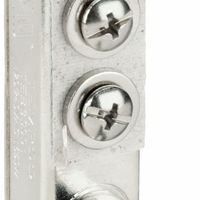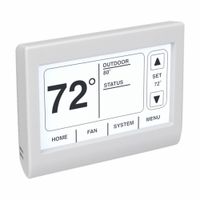Call +(254) 703 030 000 / 751 483 999 / 721 704 777
- Home
- Hvac And Refrigeration
- Hvac Controls And Thermostats
- Thermostats
.....Read More
Frequently Asked Questions
How do I install a thermostat for my HVAC system?
1. **Turn Off Power**: Switch off the power to your HVAC system at the circuit breaker to ensure safety.
2. **Remove Old Thermostat**: Detach the cover of the old thermostat. Unscrew and label each wire with masking tape according to the terminal it connects to (e.g., R, W, Y, G, C).
3. **Mount New Thermostat Base**: Remove the new thermostat's cover. Position the base on the wall, using a level to ensure it's straight. Mark the mounting holes, drill pilot holes, and use wall anchors if necessary. Feed the wires through the base and secure it to the wall with screws.
4. **Connect Wires**: Attach the labeled wires to the corresponding terminals on the new thermostat base. Ensure each wire is securely fastened. If your system uses a C-wire (common wire), connect it to provide continuous power to the thermostat.
5. **Attach Thermostat Cover**: Snap or screw the thermostat cover onto the base, ensuring it fits securely.
6. **Restore Power**: Turn the power back on at the circuit breaker.
7. **Configure Thermostat**: Follow the manufacturer's instructions to set up the thermostat. This may include setting the date and time, selecting heating/cooling modes, and programming temperature schedules.
8. **Test System**: Adjust the thermostat settings to test both heating and cooling functions, ensuring the system responds appropriately.
9. **Finalize Setup**: If your thermostat is smart, connect it to Wi-Fi and download the corresponding app for remote control and additional features.
10. **Consult Manual**: Refer to the user manual for any specific features or troubleshooting tips related to your thermostat model.
What is the best thermostat for energy efficiency?
The best thermostat for energy efficiency is the Google Nest Learning Thermostat. This smart thermostat is designed to optimize energy usage by learning your schedule and preferences, automatically adjusting the temperature to save energy when you're away or asleep. It features a sleek design and is compatible with most HVAC systems.
The Nest Learning Thermostat uses advanced algorithms to learn your habits and create a personalized schedule. It can be controlled remotely via a smartphone app, allowing you to adjust settings from anywhere. The thermostat also provides energy reports, helping you understand your energy usage and identify ways to save more.
Additionally, the Nest Learning Thermostat integrates with other smart home devices and platforms, such as Google Assistant and Amazon Alexa, for voice control and seamless automation. Its "Farsight" feature lights up the display when you enter the room, showing the time, temperature, or weather, adding convenience and functionality.
The thermostat's "Home/Away Assist" feature uses sensors and your phone's location to determine if you're home or away, adjusting the temperature accordingly to maximize energy savings. It also offers "Eco Temperatures," which are preset energy-saving temperatures that can be activated when you're not home.
Overall, the Google Nest Learning Thermostat is highly regarded for its ability to reduce energy consumption, ease of use, and integration with smart home systems, making it a top choice for those seeking energy efficiency.
How do I troubleshoot a thermostat that is not working?
1. **Check Power Supply**: Ensure the thermostat is receiving power. Check circuit breakers and fuses. Replace batteries if it's battery-operated.
2. **Inspect Settings**: Verify that the thermostat is set to the correct mode (heat/cool) and the desired temperature is set correctly.
3. **Examine Wiring**: Turn off power and remove the thermostat cover. Check for loose, disconnected, or corroded wires. Ensure wires are connected to the correct terminals.
4. **Calibrate Thermostat**: Use a thermometer to check room temperature. If there's a discrepancy, recalibrate the thermostat according to the manufacturer's instructions.
5. **Check for Dirt and Debris**: Dust and debris can affect performance. Gently clean the thermostat with a soft brush or cloth.
6. **Inspect the Circuit Board**: Look for signs of damage or burnt components on the circuit board. If damaged, consider replacing the thermostat.
7. **Test the Thermostat**: Bypass the thermostat by connecting the red (R) wire directly to the white (W) wire for heating or the yellow (Y) wire for cooling. If the system turns on, the thermostat may be faulty.
8. **Check HVAC System**: Ensure the HVAC system is functioning. Listen for unusual noises or check for error codes on the system.
9. **Reset the Thermostat**: Reset the thermostat to factory settings. Refer to the user manual for specific instructions.
10. **Consult the Manual**: Refer to the thermostat’s manual for troubleshooting tips specific to your model.
11. **Professional Help**: If issues persist, contact a professional HVAC technician for further diagnosis and repair.
Can I use a smart thermostat with my existing HVAC system?
Yes, you can use a smart thermostat with your existing HVAC system, provided that your system is compatible with the smart thermostat you choose. Most modern HVAC systems are compatible with smart thermostats, but there are a few considerations to keep in mind:
1. **Compatibility**: Check the compatibility of the smart thermostat with your HVAC system. Most smart thermostats work with common systems like central heating, air conditioning, heat pumps, and boilers. However, some older or more complex systems may not be compatible.
2. **C-Wire Requirement**: Many smart thermostats require a common wire (C-wire) for power. If your current thermostat setup lacks a C-wire, you may need to install one or choose a smart thermostat model that doesn't require it.
3. **Voltage**: Ensure that your HVAC system operates on the standard low-voltage (24V) system, as most smart thermostats are designed for this. High-voltage systems (110V or 240V) typically found in electric baseboard heating are not compatible with most smart thermostats.
4. **Features**: Consider the features you want, such as remote control via smartphone, learning capabilities, energy usage reports, and integration with smart home systems like Amazon Alexa or Google Assistant.
5. **Installation**: Installation is usually straightforward, but if you're not comfortable with electrical work, consider hiring a professional. Some smart thermostats come with detailed instructions and online support to assist with installation.
6. **Wi-Fi Connection**: Ensure you have a stable Wi-Fi connection, as smart thermostats rely on it for remote access and updates.
By ensuring compatibility and considering these factors, you can successfully integrate a smart thermostat with your existing HVAC system, enhancing comfort and energy efficiency.
How do I program my thermostat for optimal performance?
To program your thermostat for optimal performance, follow these steps:
1. **Understand Your Thermostat**: Identify if it's programmable, smart, or manual. Refer to the user manual for specific instructions.
2. **Set a Schedule**: Program the thermostat based on your daily routine. For weekdays, set the temperature lower when you're asleep or away and higher when you're home. For weekends, adjust according to your presence.
3. **Temperature Settings**:
- **Winter**: Set the temperature to 68°F (20°C) when home and awake, and lower it by 7-10°F (4-6°C) when asleep or away.
- **Summer**: Set it to 78°F (26°C) when home and higher when away.
4. **Utilize Features**: Use features like "vacation mode" for extended absences and "override" for temporary changes without altering the schedule.
5. **Zoning**: If available, program different zones in your home to optimize comfort and efficiency.
6. **Regular Updates**: Adjust the schedule seasonally and after any significant lifestyle changes.
7. **Smart Thermostats**: If using a smart thermostat, enable learning features and connect it to Wi-Fi for remote access and updates.
8. **Energy-Saving Tips**:
- Use ceiling fans to circulate air.
- Ensure proper insulation and seal leaks.
- Use curtains or blinds to manage sunlight.
9. **Maintenance**: Regularly replace air filters and ensure the thermostat is clean and functioning properly.
10. **Consult Professionals**: If unsure, consult HVAC professionals for advice tailored to your system and home.
By following these steps, you can ensure your thermostat is programmed for energy efficiency and comfort.
What are the benefits of using a programmable thermostat?
A programmable thermostat offers several benefits that enhance comfort, efficiency, and cost savings:
1. **Energy Efficiency**: By allowing users to set specific temperatures for different times of the day, programmable thermostats reduce energy consumption. This precision helps avoid unnecessary heating or cooling when the home is unoccupied, leading to significant energy savings.
2. **Cost Savings**: Reduced energy usage directly translates to lower utility bills. By optimizing heating and cooling schedules, homeowners can save up to 10-30% on their energy costs annually.
3. **Consistent Comfort**: Programmable thermostats maintain a consistent temperature by automatically adjusting settings based on pre-set schedules. This ensures a comfortable environment without manual intervention.
4. **Convenience**: Users can program the thermostat to adjust temperatures automatically, eliminating the need for manual changes. This is particularly beneficial for maintaining comfort during sleep or when returning home from work.
5. **Customization**: These devices offer flexibility to create multiple schedules tailored to individual lifestyles. Users can set different temperatures for weekdays and weekends or even for specific times of the day.
6. **Remote Access**: Many modern programmable thermostats come with Wi-Fi connectivity, allowing users to control settings remotely via smartphones or computers. This feature is useful for making adjustments on the go.
7. **Environmental Impact**: By optimizing energy use, programmable thermostats contribute to reducing carbon footprints, supporting environmental sustainability.
8. **Zoning Capabilities**: Some advanced models allow for zoning, where different areas of a home can be heated or cooled independently, further enhancing efficiency and comfort.
9. **Learning Features**: Smart programmable thermostats can learn user preferences over time and adjust settings automatically, improving efficiency without user input.
Overall, programmable thermostats offer a blend of convenience, cost-effectiveness, and environmental benefits, making them a valuable addition to modern homes.
How do I connect my thermostat to a building automation system?
To connect your thermostat to a building automation system (BAS), follow these steps:
1. **Identify Compatibility**: Ensure your thermostat is compatible with the BAS. Check the manufacturer's specifications for compatibility with the system's communication protocols like BACnet, Modbus, or Zigbee.
2. **Gather Necessary Tools and Materials**: You may need screwdrivers, wire strippers, and possibly a laptop or tablet for software configuration.
3. **Power Off**: Turn off power to the thermostat and the HVAC system to prevent electrical shock or damage.
4. **Wiring**: Access the thermostat's wiring panel. Connect the appropriate wires from the thermostat to the BAS interface. Typically, this involves connecting power, ground, and communication wires. Refer to both the thermostat and BAS manuals for specific wiring diagrams.
5. **Install Communication Module**: If required, install a communication module or adapter that allows the thermostat to communicate with the BAS. This could be a physical module or a software update.
6. **Configure Network Settings**: Use the BAS software to add the thermostat to the network. Assign an IP address or network ID to the thermostat, ensuring it is recognized by the system.
7. **Program Thermostat**: Set up the thermostat's settings through the BAS interface. This includes scheduling, temperature setpoints, and any other control parameters.
8. **Test Connection**: Verify the connection by checking if the BAS can read data from and send commands to the thermostat. Adjust settings as necessary to ensure proper communication.
9. **Finalize Setup**: Secure all wiring and replace any covers. Restore power to the system and perform a final test to ensure everything is functioning correctly.
10. **Documentation**: Record the setup details, including wiring diagrams and network settings, for future reference or troubleshooting.



